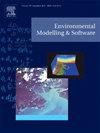反硝化分解模型在中国应用的基准建议:来自文献分析的见解
IF 4.8
2区 环境科学与生态学
Q1 COMPUTER SCIENCE, INTERDISCIPLINARY APPLICATIONS
引用次数: 0
摘要
该研究解决了反硝化分解(DNDC)模型缺乏标准化评估标准的问题,该模型被广泛用于评估农业系统的温室气体排放。在对文献数据进行综合分析的基础上,以中国农业为背景,以作物产量、土壤有机碳(SOC)、氧化亚氮(N2O)和甲烷(CH4)排放为指标,提出了一套提高模型可靠性的基准。定义关键绩效指标,包括相关系数(R)、归一化均方根误差(nRMSE)和一致性指数(IOA),以加强模型的校准和验证。拟议的基准旨在为DNDC应用提供一致的参考,促进对温室气体排放的准确评估,并支持可持续农业实践。通过综合现有研究,本研究有助于提高模型准确性和加强农业管理策略,对减缓气候变化具有重要意义。本文章由计算机程序翻译,如有差异,请以英文原文为准。

Recommendations on benchmarks for the DeNitrification–DeComposition model application in China: Insights from literature analysis
This study addresses the lack of standardized evaluation criteria for the DeNitrification–DeComposition (DNDC) model, widely used to assess greenhouse gas emissions in agricultural systems. Based on a comprehensive analysis of literature data, we propose a set of benchmarks to improve the model's reliability, focusing on crop yield, soil organic carbon (SOC), nitrous oxide (N2O), and methane (CH4) emissions within the context of Chinese agriculture. Key performance indicators, including correlation coefficient (R), normalized root mean square error (nRMSE), and index of agreement (IOA), are defined to enhance model calibration and validation. The proposed benchmarks aim to provide a consistent reference for DNDC applications, facilitating accurate assessments of greenhouse gas emissions and supporting sustainable agricultural practices. By synthesizing existing research, this study contributes to improving model accuracy and enhancing agricultural management strategies, with implications for climate change mitigation.
求助全文
通过发布文献求助,成功后即可免费获取论文全文。
去求助
来源期刊

Environmental Modelling & Software
工程技术-工程:环境
CiteScore
9.30
自引率
8.20%
发文量
241
审稿时长
60 days
期刊介绍:
Environmental Modelling & Software publishes contributions, in the form of research articles, reviews and short communications, on recent advances in environmental modelling and/or software. The aim is to improve our capacity to represent, understand, predict or manage the behaviour of environmental systems at all practical scales, and to communicate those improvements to a wide scientific and professional audience.
 求助内容:
求助内容: 应助结果提醒方式:
应助结果提醒方式:


